There are now many ways to cross the River Thames in Central London – although for many years, the only bridge across the river was London Bridge. Originally built by the Romans and moved from its original site, London Bridge was replaced in 1971 by a modern bridge that takes people from Southwark to the City and affords them fine views of Tower Bridge. This article looks at each of the major bridges over the River Thames in London, starting with the famous Tower Bridge.
Tower Bridge
Most visitors to London see Tower Bridge on a visit to the capital and you can now walk over the top of the bridge seeing the Thames below you. If you are lucky, you might see the bridge open up to allow ships to travel past its famous towers. It takes its name from the Tower of London which it stands next to although the Tower is nearly 1,000 years old, having been built by William the Conqueror in 1086 while Tower Bridge was opened in 1875.
The Tower of London was built by the Norman conquerors to demonstrate who was now in charge. William the Conqueror was crowned on Christmas day in 1066 and soon built a dozen castles to protect his newly won kingdom. Only Windsor Castle, which protected the western approach to London, and the Tower guarding the eastern side of the city now survive.
Tower Bridge was built in the late nineteenth century and is the only bridge in London that opens up. Its giant roadways – or bascules – are raised about a thousand times a year to allow tall ships and yachts to sail beneath its towers. Opening the bridge is a free service to anyone with enough money to afford a big enough ship to require the bridge to open.
Tower Bridge itself has been open as an attraction since 1982. For a fee, visitors can walk between the towers and see the workings of the machinery that opens the roadway. They need not worry about falling down as the reinforced glass floors on these walkways are capable of supporting the equivalent of six London taxis – or four elephants – on them!
For more on Tower Bridge and to check the times and dates of openings, go to their website.
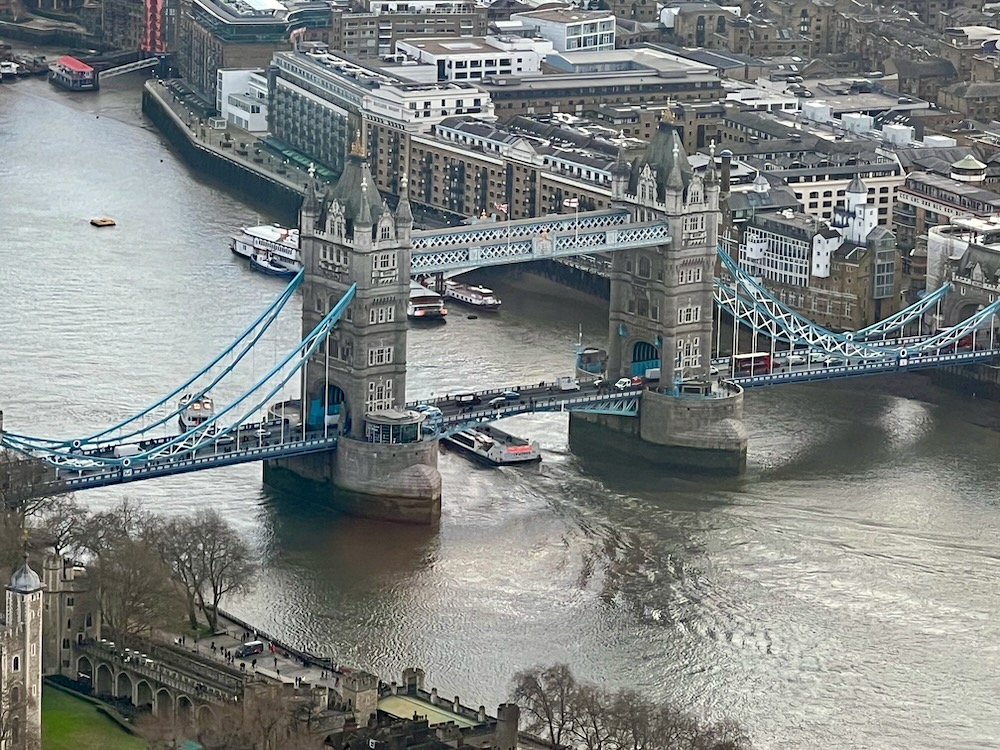 View of Tower Bridge from Horizon 22. Photo Credit: © Ursula Petula Barzey.
View of Tower Bridge from Horizon 22. Photo Credit: © Ursula Petula Barzey.
London Bridge
Although all Blue Badge Tourist Guides know the difference between them, visitors to London often confuse Tower Bridge and London Bridge. There is even a story that the American businessman Robert McCulloch, who bought London Bridge for a million dollars around 1970, thought that he was buying Tower Bridge instead! This, however, is an urban myth. McCulloch was a shrewd businessman who knew exactly what he was doing and thought that he needed an attraction for his new housing development by Lake Havasu in Arizona in order to encourage people to move there. He would have known that buying the iconic landmark Tower Bridge was not on the agenda and so opted instead to buy London Bridge. He spent around ten million dollars shipping the bridge to Havasu and it turned out to be a great success. The bridge is still there, attracting students who go to Havasu in spring break.
The reason the City of London wanted to sell London Bridge was that it was no longer strong enough to take the heavy traffic that was going over and so it had to be replaced. The late queen opened the new bridge in 1971 and you can see a plaque there recording the event.
Although it does not look as spectacular as Tower Bridge, there is a great deal of history in London Bridge which served as the only bridge over the river in London for many centuries. The City of London, which controls London bridge, and the watermen, who plied a lucrative trade rowing people across the Thames, persistently opposed proposals to build a new bridge and it was not until 1750, when Westminster Bridge was built, that this happened.
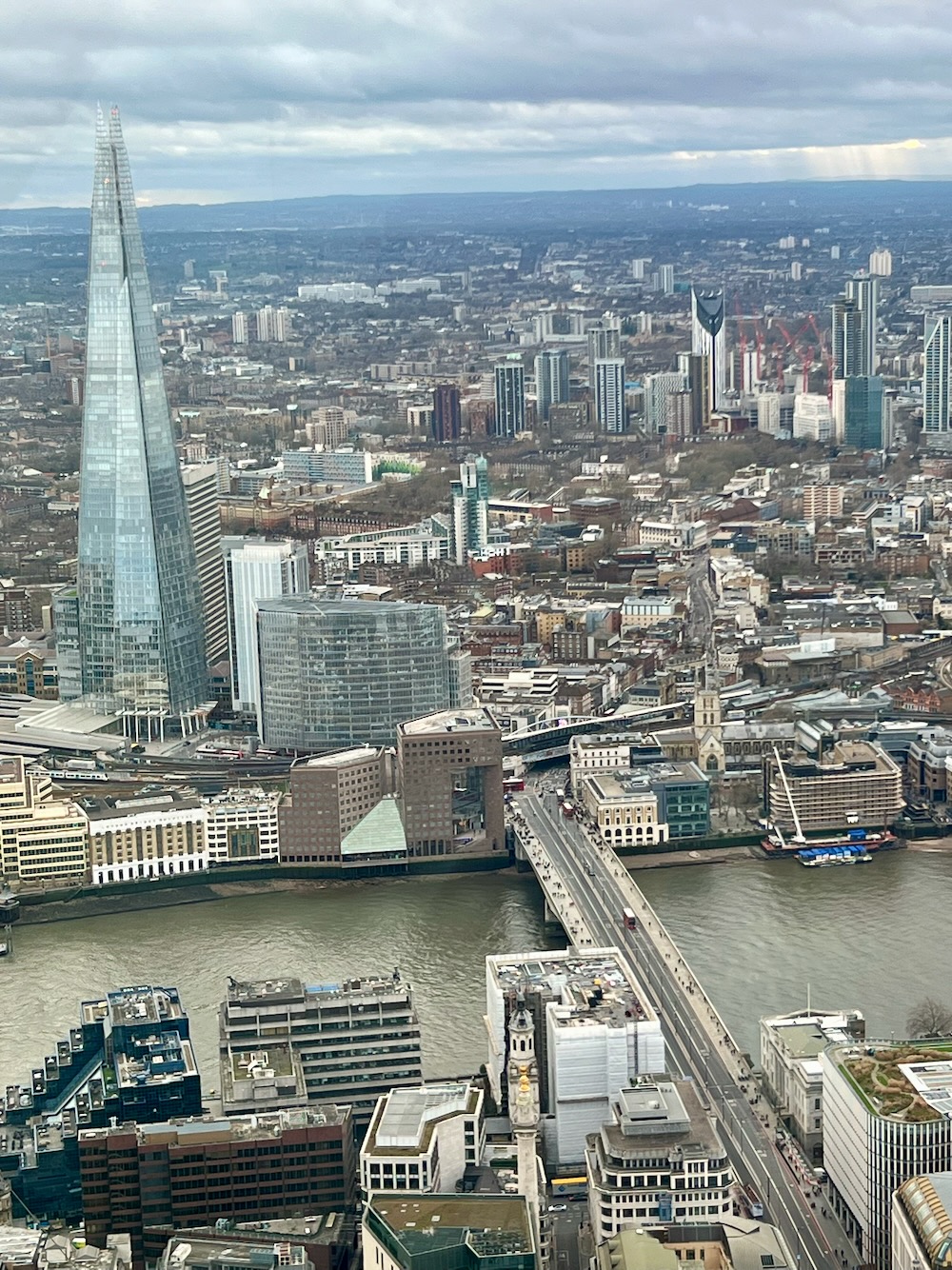 View of London Bridge from Horizon 22. Photo Credit: © Ursula Petula Barzey.
View of London Bridge from Horizon 22. Photo Credit: © Ursula Petula Barzey.
Cannon Street Railway Bridge
The next bridge over the River Thames is for trains only. Its name has nothing to do with cannons in battle but comes from the fact that candlemakers used to be based there. The bridge, which was opened in 1866 and belongs to Network Rail, was designed to take trains to Cannon Street railway station, where commuters work in the City of London. It was originally named Alexandra Bridge in honour of the lady who came from Denmark to marry Queen Victoria’s son, the Prince of Wales (later King Edward VII). Two towers on the north side of the bridge make it one of the most distinctive and noticeable bridges in London.
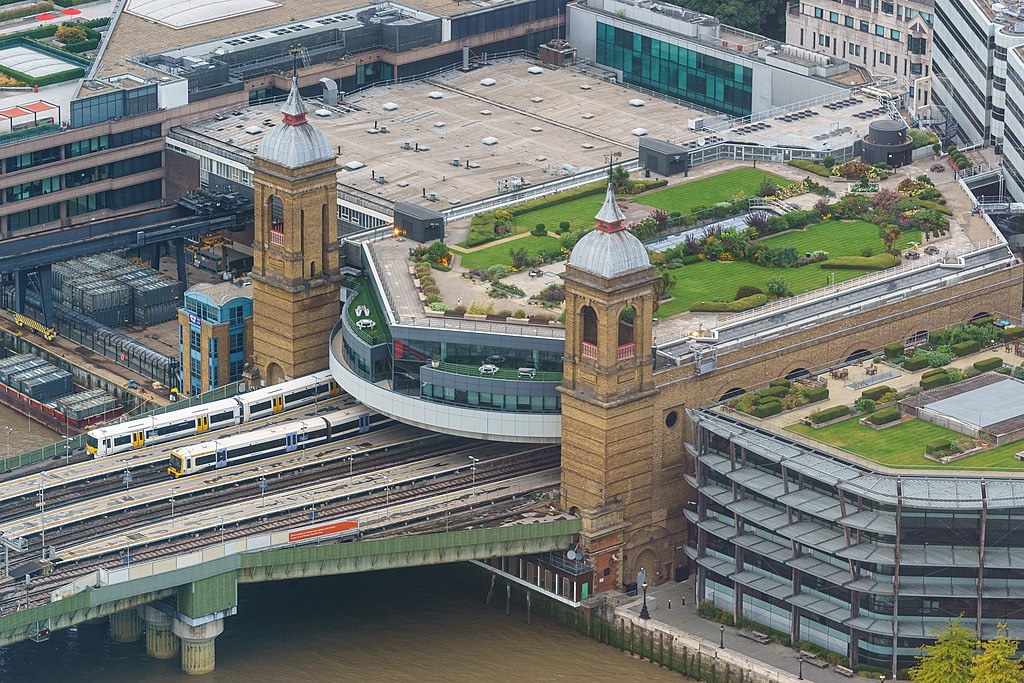 Cannon Street Station seen from The Shard, showing roof garden and twin towers. Photo Credit: © Colin via Wikimedia Commons.
Cannon Street Station seen from The Shard, showing roof garden and twin towers. Photo Credit: © Colin via Wikimedia Commons.
Southwark Bridge
William Shakespeare would never has known this bridge, which was opened in 1921 over three centuries after his death. However, it leads goes from Southwark, a popular part of London where he is remembered to the City. There is a statue of the playwright sitting on one of the benches in the grounds of the nearby Southwark Cathedral and the Globe Theatre, where many of his plays have been performed, was rebuilt by the American actor and director Sam Wannamaker at the end of the twentieth century. Shakespeare’s plays are regularly performed there in the open and many visitors of London either do a tour of the theatre or see it from the outside on a walk along the south bank of the River Thames.
In Shakespeare’s day, the theatres were not allowed into the City of London, so they had to ply their trade outside. As a young man wanting to make his mark in the theatre, he went first to the east end of London and then, after an argument with the owner of the lease there, the company moved their theatre to Southwark in 1599. The events of this year are described vividly in 1599, a prize-winning book by the American academic James Shapiro.
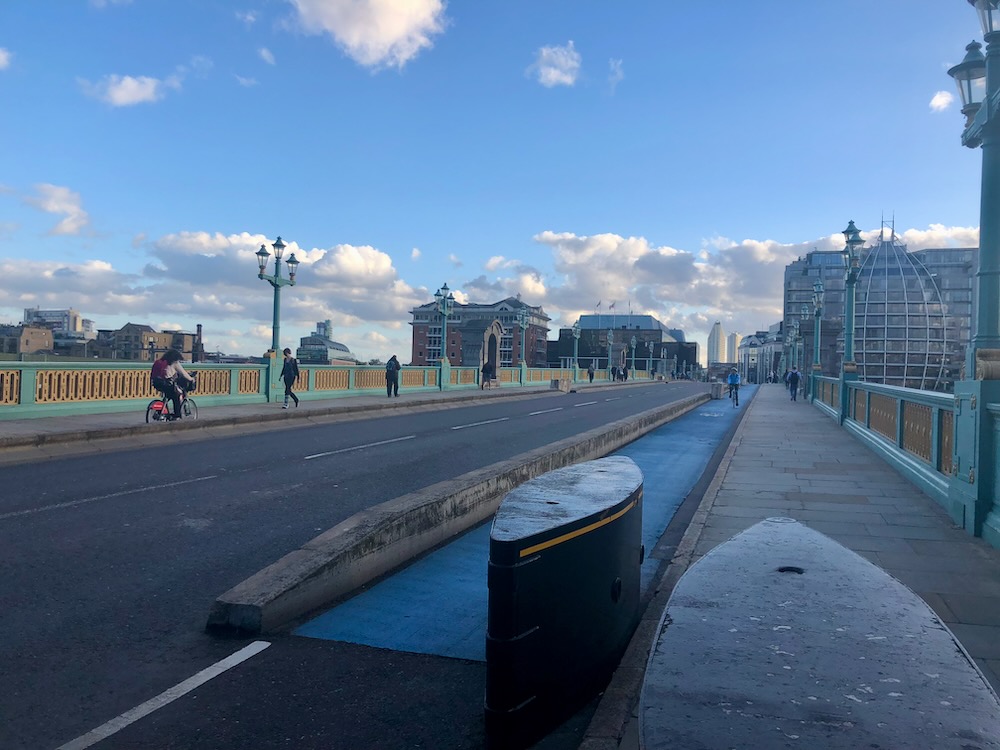 Walking over Southwark Bridge. Photo Credit: © Ursula Petula Barzey.
Walking over Southwark Bridge. Photo Credit: © Ursula Petula Barzey.
Millennium Bridge
Some visitors to London – and locals – will approach the Globe and the popular Tate Modern Museum by walking over the Millennium Bridge from Saint Paul’s cathedral. This bridge gained the unfortunate and unenviable nickname of ‘the wibbly wobbly bridge’ after it was opened for the first time in June 2000. The bridge had to be hurriedly closed just two days after this because the designers, who included the well-known architect Lord Foster and the artist Sir Anthony Caro, had not realised that people walking together subconsciously walk in step. This had the effect of making the bridge feel unstable and gave it that unfortunate nickname. The fault was corrected, and Millennium Bridge is now open to the public and a popular method of walking over the Thames. The nickname, however, has stubbornly stuck to it.
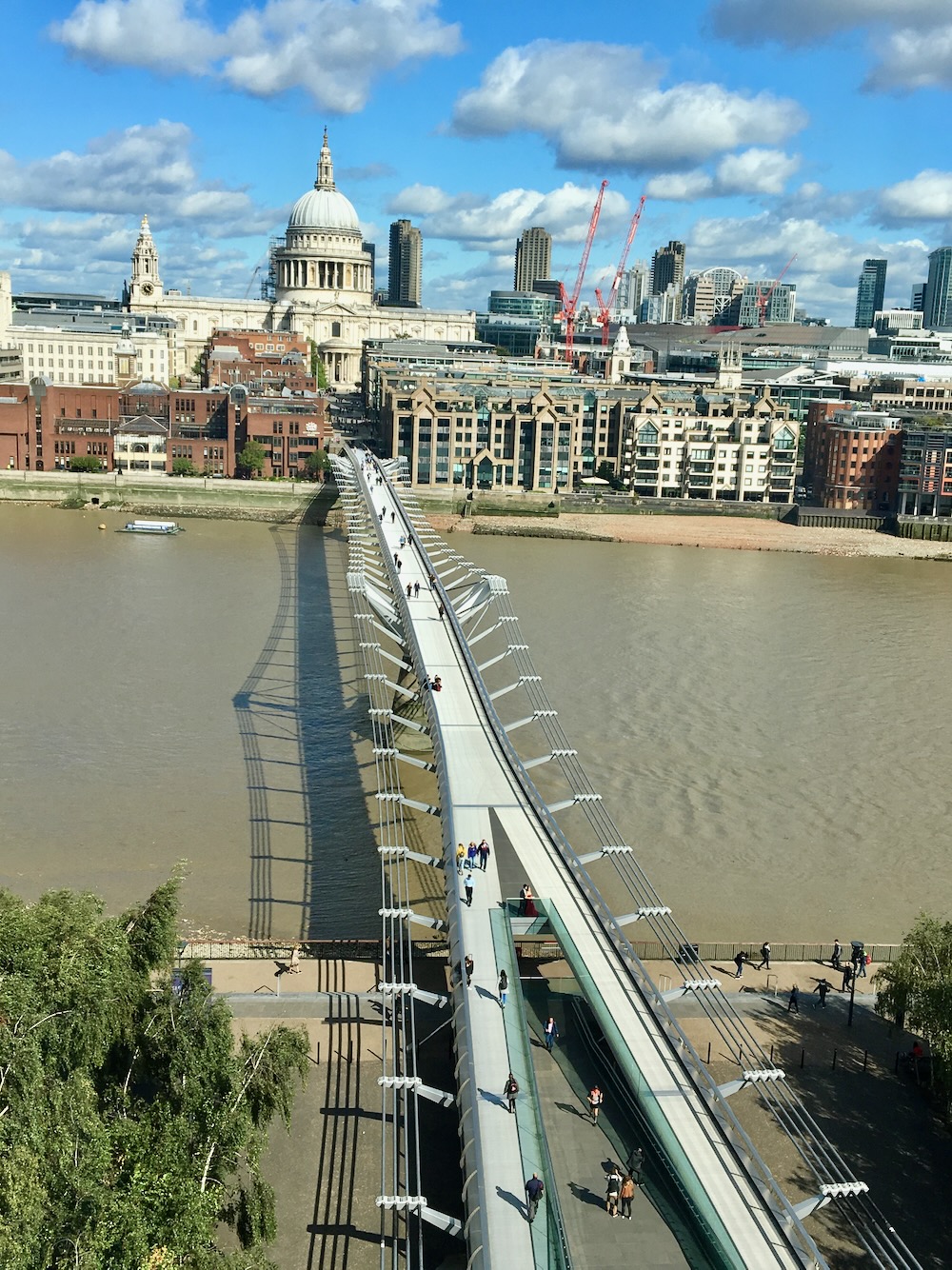 View of London Millennium Bridge from Tate Modern. Photo Credit: © Ursula Petula Barzey.
View of London Millennium Bridge from Tate Modern. Photo Credit: © Ursula Petula Barzey.
Blackfriars Bridges
The next bridges down from the Millennium are the Blackfriars Bridges. They are named after an ancient Dominican monastery which was housed on the north side of the Thames near Saint Paul’s Cathedral. This is long gone, a victim of the Dissolution of the Monasteries in the 1530s, and all that remains of it is a pub with a jolly (and overweight) monk standing as a statue on the outside. Although the first bridge was originally named after then Prime Minister William Pitt, the name Blackfriars – which is applied to the area and to the railway station serving it – soon became attached to the bridge and has stuck ever since.
There are actually three – or two and a half – Blackfriars Bridges in London. The easternmost is the Blackfriars Railway Bridge, which was opened in 1985 and replaced the original railway bridge from 1864. However, two columns from the old railway bridge have been preserved as Grade Two listed structures and can be clearly seen on a boat trip along the Thames. Blackfriars station, which stands on the bridge, is Britain’s only solar-powered train station.
The railway bridge is next to the Blackfriars Road Bridge, which was originally the third bridge over the Thames and was opened in 1769 as a toll bridge. It was later rebuilt and reopened by Queen Victoria 100 years after the original. A statue of Queen Victoria now stands at the north end of the bridge above where the River Fleet discharges into the Thames. The Fleet is one of London’s underground rivers and gives its name to nearby Fleet Street, for many years home of London’s newspaper industry. The rebuilding of the brdge coincided with the construction of the Thames Embankment sewage system, which was designed by Sir Joseph Bazalgette and which did a great deal to clean up London. Bazalgette is honoured with a small bust on the embankment near the north side of the bridge.
 Blackfriars Bridge, seen from Waterloo Bridge in London. Photo Credit: © Public Domain via Wikimedia Commons.
Blackfriars Bridge, seen from Waterloo Bridge in London. Photo Credit: © Public Domain via Wikimedia Commons.
Blackfriars Railway Bridge is maintained by Network Rail and Blackfriars Road Bridge is the westernmost bridge maintained by the City of London Corporation. To its east is:
Waterloo Bridge
We leave the City of London now and move towards Westminster. London’s history is a tale of two cities: Westminster and London itself. (Think New York and Washington DC in the USA.) These two cities were originally separate entities but, being geographically close to each other, they later merged and as the capital expanded Greater London came into being. It now consists of the City plus thirty-two boroughs and a population of nine million people.
The City, as it is always known to Londoners, is home to many businesses and finance companies who like to nestle cheek by jowl in the roughly one square mile of the old Roman city of Londinium. The Romans built a wall around it, which you can still see in places, not least in street names like the aptly named London Wall. Probably the best place to get a good view of the wall is outside Tower Hill underground station near the Tower of London. You can also see the top of Tower Bridge from here and join a Jack the Ripper walking tour every evening from the tube station if you are so inclined. (Include me out, by the way.)
Back to Westminster and the first bridge you come to is named after the battle of Waterloo, Napoleon’s final battle which was fought ten miles south of Brussels and resulted in the loss of around 50,000 men. Many of these were wounded but it was long before the days of Florence Nightingale, so many of them died from their wounds afterwards. Neither Wellington nor Napoleon fought another battle during the rest of their lives. Napoleon was exiled to the island of Saint Helena and died there six years later. Wellington retired from soldiering and became a politician, serving briefly as Britain’s Prime Minister before his death as the grand old man of the United Kingdom in 1852. This was around the time when Britain fought its next war after the defeat of Napoleon, against the Russians in Crimea.
The victory at Waterloo had to be commemorated in some way and both a railway station and a bridge were given the name in honour of Wellington’s triumph, which actually owed a good deal to the efforts of the Prussian army that fought by the side of his men. The bridge had already been designed by the engineer John Rennie but it was hastily renamed after the battle and remained in situ until it was replaced during the Second World War. This bridge is sometimes referred to as “the Ladies’ Bridge” because the workforce that completed it was largely female, the original and mainly male workforce fighting against Germany, the same country that had helped Wellington to win the battle after which the bridge is named.
For tourist guides the bridge is a useful way of summing up the difference between the two sides of London, the City to the east where the financial companies occupy tall buildings that surround Saint Paul’s Cathedral and Westminster to, inevitably, the west where Britain’s government is conducted. You can quite clearly see both the dome of Saint Paul’s and the clock tower of the Palace of Westminster, which everyone calls Big Ben, from the bridge. Big Ben is actually the name of the bell not the clock but this does not stop people misnaming it.
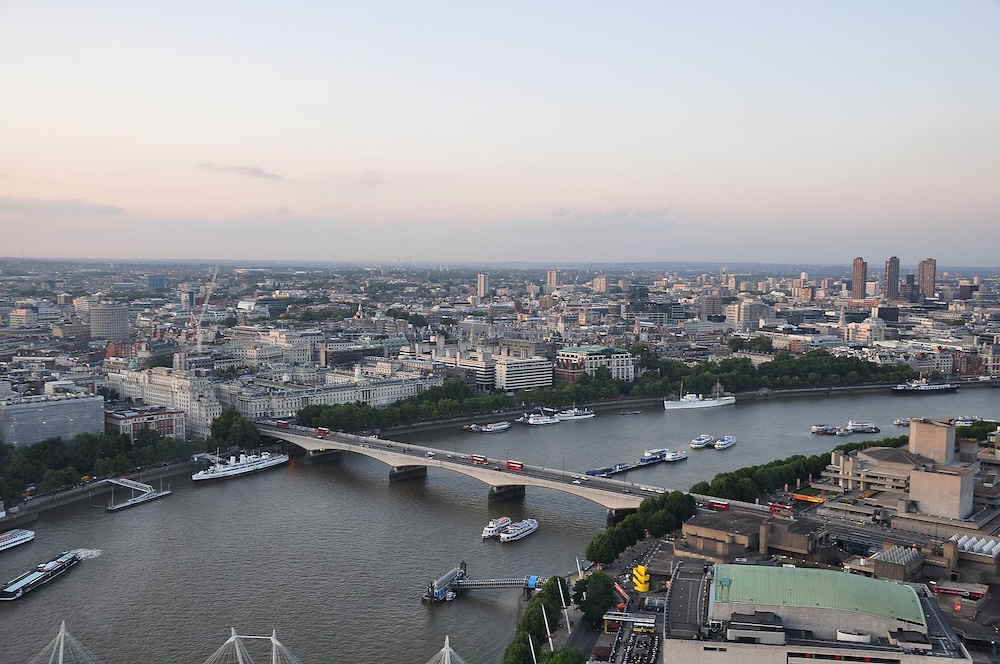 View of River Thames and Waterloo Bridge in London. Photo Credit: © Tom Arthur via Wikimedia Commons.
View of River Thames and Waterloo Bridge in London. Photo Credit: © Tom Arthur via Wikimedia Commons.
Hungerford Bridge and Golden Jubilee Bridges
You have to pass by or over (more likely, under) another bridge before you reach Big Ben from Waterloo. This is the Hungerford Railway Bridge and you might spot the statue of its designer, the great Victorian engineer Isambard Kingdom Brunel, which stands on the north side of the river at Victoria Embankment not far from that of the other less celebrated but equally important Victorian engineer Joseph Bazalgette. Brunel did most of his work above ground, Bazalgette beneath it, so perhaps that is why he is remembered more prominently than his below ground equivalent. Maybe it is just because we prefer bridges to sewers.
Whatever the reason, Brunel is revered by many in Britain and was responsible for railways, steamships and bridges. Despite his connection with railways, the bridge named after the market, which used to be where Charing Cross Station now stands, was designed by Brunel as a footbridge and opened in 1845. It was later purchased by the railway company that also built Charing Cross Station and new walkways were added in the late twentieth century. Coming from the east, it is the first bridge in London to accommodate both trains and pedestrians. (There are two others – Fulham Bridge and Barnes Bridge – farther west.) Hungerford Bridge is a handy way of walking across the Thames from Embankment Station to Waterloo and was used by many who were coming to visit the Festival of Britain in 1951.
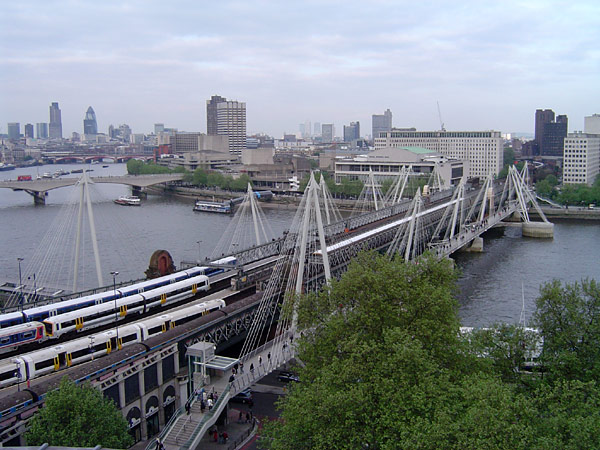 Hungerford Bridge in London. Photo Credit: © ChrisO via Wikimedia Commons.
Hungerford Bridge in London. Photo Credit: © ChrisO via Wikimedia Commons.
Westminster Bridge
Then we come to Westminster Bridge which leads across to the Houses of Parliament and Big Ben. Correctly, they should be known as the Palace of Westminster and the Elizabeth Tower, which was named after the late queen and stands close to where she lay in state after her death in 2022. (Former footballer David Beckham was one of many who waited patiently in line to pay their respects to her.) However, most people refer to the Houses of Parliament and Big Ben when talking about these iconic sights which sum up London for many visitors.
No-one knows for certain where the name “Big Ben” comes from. Two theories persist, the first being that the bell was named after Benjamin Hall, an imposing man who was the Minister of Public Works when it was built. The other is that it was named after the boxer Benjamin Hall, another big man who was nicknamed “Big Ben” during his successful career in the ring. In any case, it is an unofficial name and may have originated during a heated (in both senses of the word) debate in the House of Commons on the matter. One MP, tired of both the heat and the endless discussion on the issue is said to have exclaimed, “Let’s call it Big Ben and have and done with the matter.” Hansard, however, remains silent on this issue.
Whatever happened all those years ago, the name Big Ben, which has a pleasing and alliterative simplicity to it, has stuck ever since, and it is from Westminster Bridge that you get the closest view of it. The best view for a photograph may be from the Vauxhall area where many tourist guides go, coaches not being allowed to stop in Parliament Square.
Walk over the bridge and you can visit Westminster Abbey, who will be happy to allow you in for a fee, but you will not be able to go inside the mother of parliaments unless you have pre-booked your visit and are prepared to go through a thorough search. So many people have felt it necessary to disrupt the proceedings of parliament in order to promote their various causes that the police are necessarily suspicious of all visitors. You will, however, be able to admire the statues of Winston Churchill, who chose the site of his memorial statue himself, and of Boudicca, queen of the Iceni tribe, who was too busy slaughtering Romans to be bothered with such niceties. Her statue stands just underneath Big Ben and Hamo Thorneycroft’s monument is inscribed with the saying “Regions Caesar never knew they posterity shall sway.” In other words, the British Empire became a lot bigger than the Roman one. Or, to put it crudely, yah boo sucks to you Romans. Our empire was bigger than yours.
From Westminster Bridge, we can also see Saint Thomas’s Hospital. With an imposing “NHS” placed on the wall, it is a reminder of the importance of Britain’s National Health Service and two famous nurses are remembered here: Florence Nightingale with a museum and Mary Seacole with a statue that you can see from the bridge. Nightingale virtually invented nursing while Seacole was an entrepreneur and much-loved by the soldiers she tended to.
Finally, Westminster Bridge was where the most famous poem about London was written. William Wordsworth’s sonnet Lines Composed Upon Westminster Bridge was published in 1805, long before Big Ben was dreamed up by the architects Sir Charles Barry and Augustus Pugin. (Their designs for the rebuilding of the palace followed a fire in 1834.) Wordsworth, was on his way to France to tell his former mistress that he intended to marry a nice English girl. He did not care for London so it is ironic that he wrote the most famous poem about the capital as he and Dorothy looked out over the Thames while hurrying away towards France.
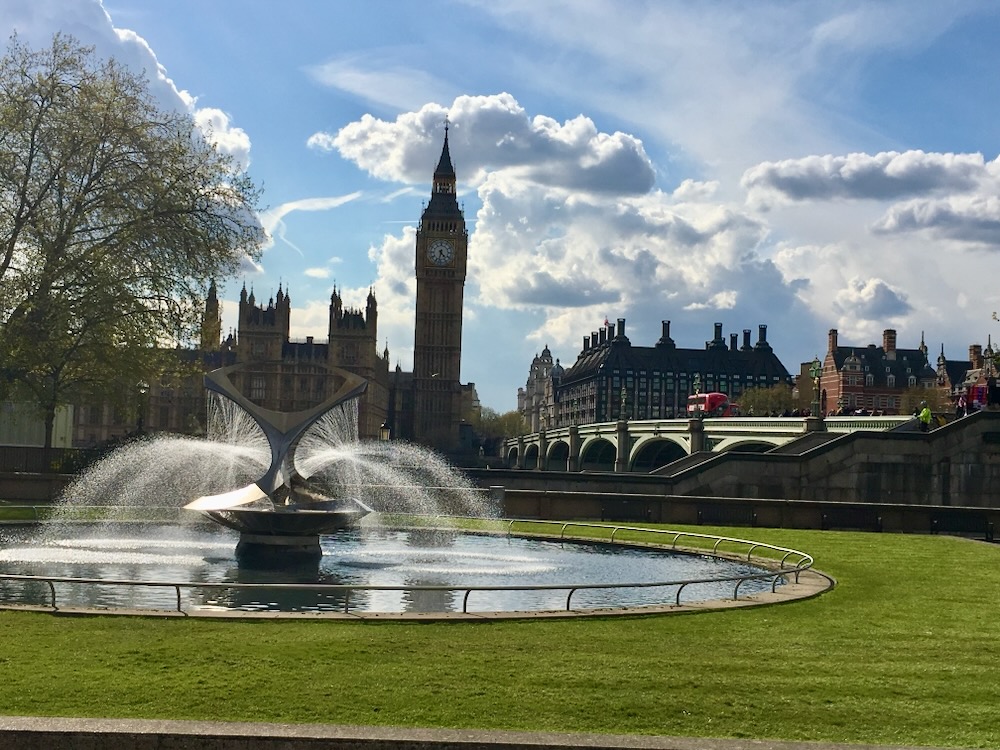 View of Big Ben and Westminster Bridge from St Thomas’ Hospital Garden. Photo Credit: © Ursula Petula Barzey.
View of Big Ben and Westminster Bridge from St Thomas’ Hospital Garden. Photo Credit: © Ursula Petula Barzey.
Lambeth Bridge
Although it is the official and established church in England, the C of E, as it is affectionately known, is separated from Parliament by the River Thames. The main national church, Westminster Abbey, is where the coronation takes place and can be reached easily once you cross over Westminster Bridge. However, Lambeth Palace, the London home and office of the Archbishop of Canterbury, who heads this church, is on the other side of the Thames.
Connecting the two is Lambeth Bridge, from where you can gain a fine view of Westminster. It was opened in 1862 and rebuilt in 1932 when it became suitable for road traffic. Before the bridge was built, a ferry for horses plied its trade across the Thames. Horseferry Road on the Westminster side of the bridge is now the sole reminder – and remnant – of this ferry.
The bridge is decorated with the colour red, which is found on the benches of the House of Lords in Westminster. On top of the obelisks at either end of the bridge stand a pair of stone pinecones, a tribute to John Tradescant who lived in Lambeth and supposedly grew Britain’s first pineapple. He is remembered in the museum at Saint Mary’s church by Lambeth Palace.
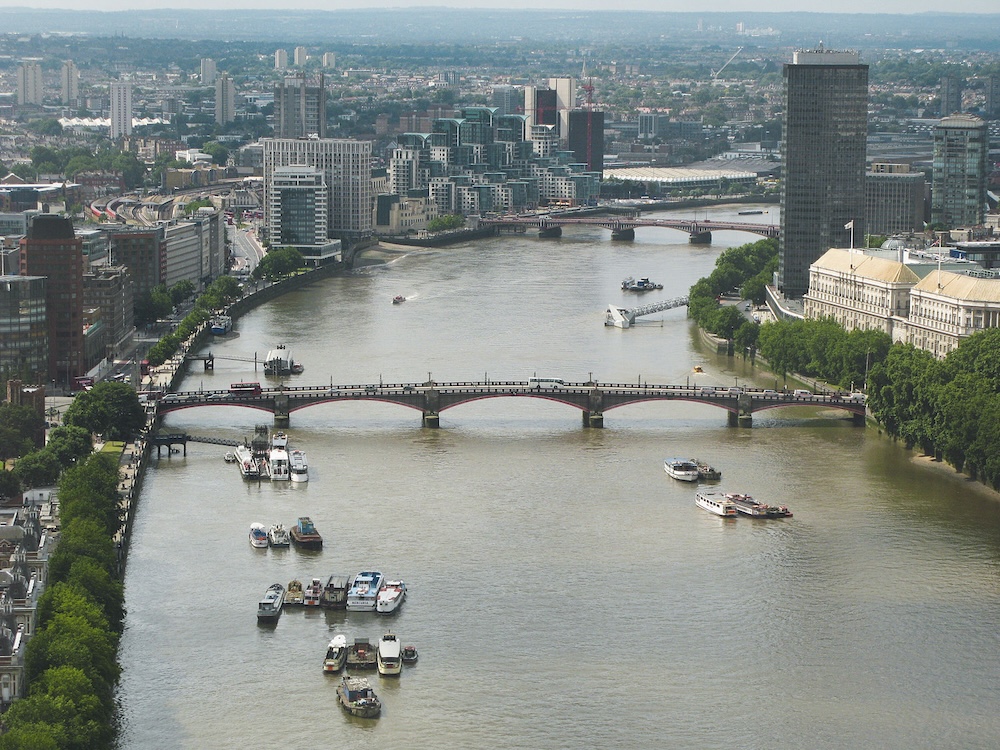 View of River Thames and Lambeth Bridge in London. Photo Credit: © Justin Norris via Wikimedia Commons.
View of River Thames and Lambeth Bridge in London. Photo Credit: © Justin Norris via Wikimedia Commons.
Vauxhall Bridge
The Vauxhall area will be forever associated with Britain’s most famous fictional spy James Bond, otherwise known by his number 007, which gave him a purely imaginary “licence to kill”. Although it did not exist in his day the Bond of the films is seen entering and leaving Vauxhall Cross, the headquarters of MI6, now known as the Secret Intelligence Service. An exciting boat chase along the Thames to the Greenwich Dome took place in the pre-credit sequence of The World is Not Enough in which Bond is portrayed by Pierce Brosnan. Daniel Craig later played Bond and Vauxhall Cross was digitally destroyed in the film Spectre, reportedly to ironic cheers when it was shown to those who have to work there today.
The current Vauxhall Bridge was built in the twentieth century and opened in 1906. It replaced an older structure which was originally called the Regent Bridge, the first iron bridge across the River Thames. Today, Vauxhall Bridge sees over 50,000 cars crossing it to and from the Pimlico area. Hardly any of the occupants of these cars will notice the two ton bronze statues on the bridge which represent such things as Agriculture, Architecture, Engineering, Pottery and other abstract concepts popular at the time when it was built.
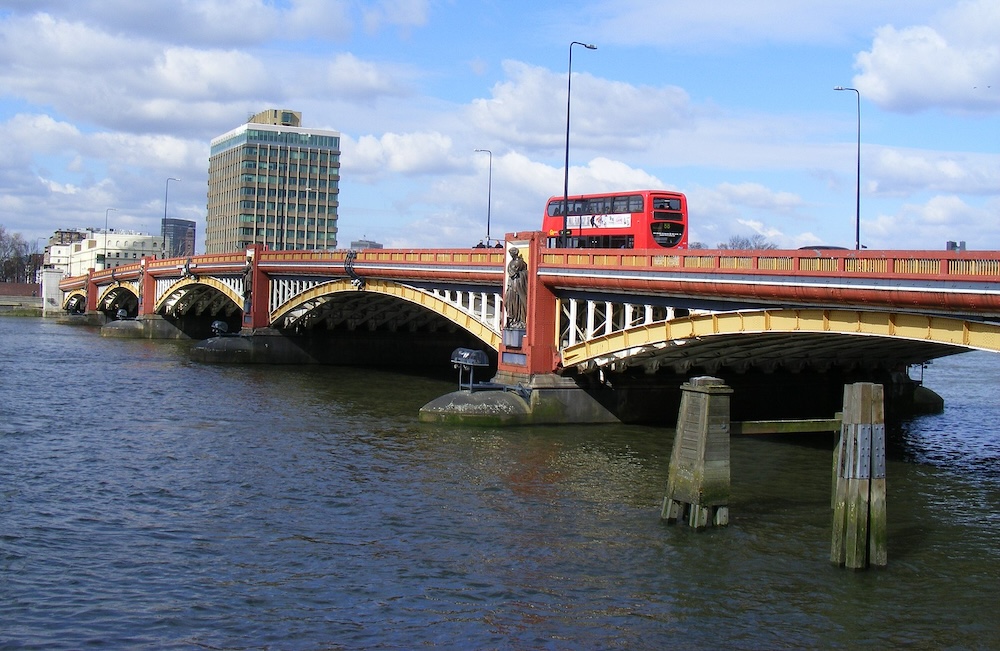 Vauxhall Bridge in London. Photo Credit: © Paul Farmer via Wikimedia Commons.
Vauxhall Bridge in London. Photo Credit: © Paul Farmer via Wikimedia Commons.
Grosvenor Railway Bridge
This is probably one of the least well-known bridges in Central London. Yet, it is both the oldest railway bridge in the capital – opened in 1860 – and the busiest in the world, bringing about a thousand trains a day into Victoria Station and providing millions of commuters with access to their offices and places of work. It was initially called the Victoria Railway Bridge, but the current name reflects that the Grosvenor family still own estates covering much of Central London. The bridge is nearly a thousand feet (300 metres) long.
 Grosvenor Bridge in London. Photo Credit: © Christopher Down via Wikimedia Commons.
Grosvenor Bridge in London. Photo Credit: © Christopher Down via Wikimedia Commons.
Chelsea Bridge
Chelsea Bridge leads across the River Thames into one of London’s most fashionable areas and towards the Royal Hospital Chelsea, home to the famous Chelsea Pensioners and also where a popular garden festival is held every May. The original Chelsea Hospital was built by London’s great architect Christopher Wren as a home for retired soldiers in the British army and many still live there and can be seen with their colourful red uniforms walking around the streets of London. The late Prime Minister Margaret Thatcher and her husband Denis were big supporters of this charity and lie buried at the northern end of the hospital.
Continue northwards after you cross the bridge and you soon come to Sloane Square in the heart of Chelsea. Off this lead the King’s Road, once home to London’s most fashionable shops, and Sloane Street, which takes you up to Harrods, London’s most famous store.
The bridge itself was opened in 1937 and, like many other bridges in London, replaced an earlier Victorian one on the site. It is used by around 30,000 cars a day and takes the drivers into an area outside the congestion zone, which they would have to pay £15 a day to enter.
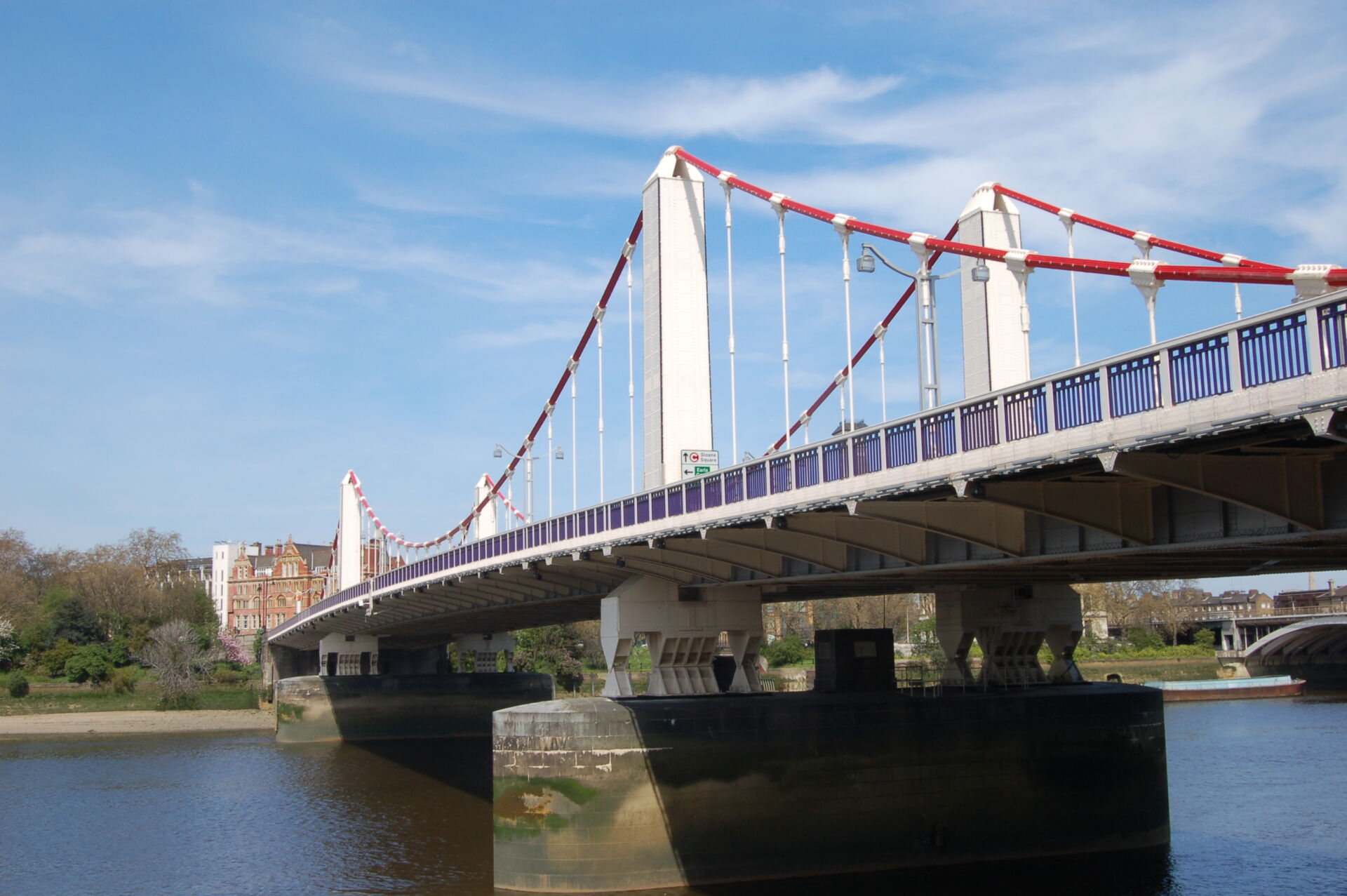 Chelsea Bridge in London. Photo Credit: © Tom Graham via Wikimedia Commons.
Chelsea Bridge in London. Photo Credit: © Tom Graham via Wikimedia Commons.
Albert Bridge
This is still the original 700 foot bridge opened in 1873 and named after Queen Victoria’s husband Prince Albert. (It is one of only two bridges in Central London that has not been replaced or rebuilt, the other being Tower Bridge.) The Albert Bridge links Chelsea and Battersea and, although cars can drive over, it is prohibited to heavy traffic. Even soldiers crossing the bridge are told to “break step” and not march in unison, as this might weaken it.
The bridge was closed and restored in the early twenty-first century. It is illuminated by 4,000 LED bulbs and is often seen in films like Clockwork Orange and One Love, the biopic of Bob Marley. He and his bandmates, who were called The Wailers, would often play football in the area and a blue plaque has been placed on the house in Chelsea where they lived.
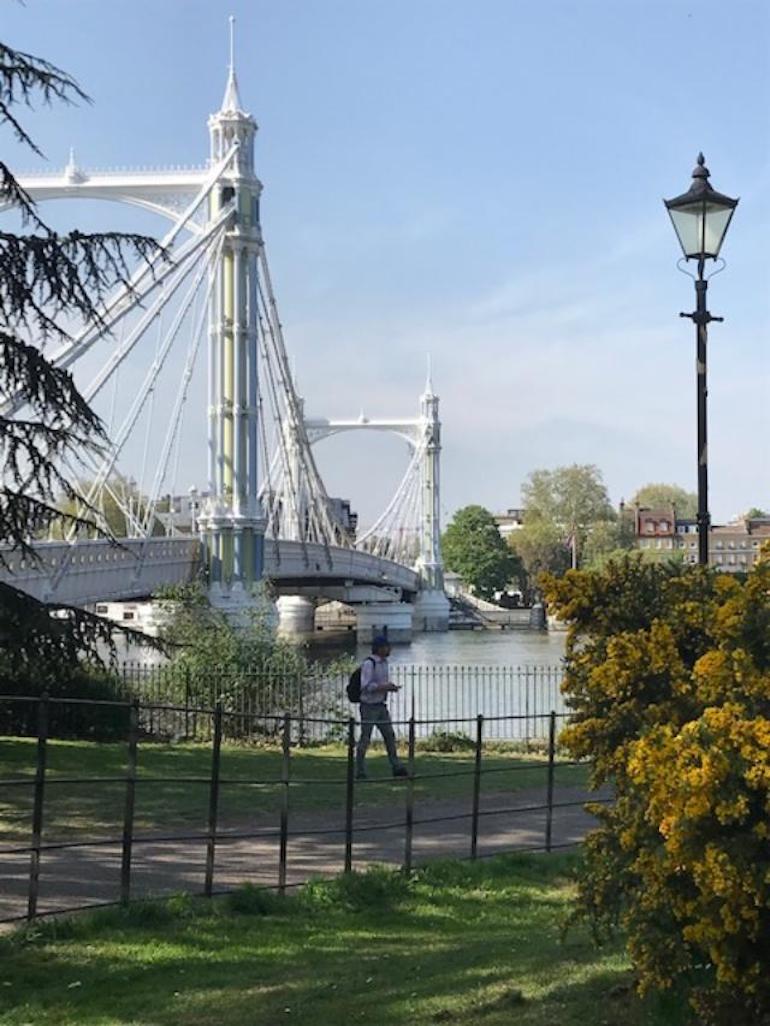 Albert Bridge and on into Chelsea, from Battersea Park. Photo Credit: © Clare McCoy.
Albert Bridge and on into Chelsea, from Battersea Park. Photo Credit: © Clare McCoy.
Battersea Bridge
This cast iron and granite bridge was built in 1890 on the site of the last wooden bridge in London which had itself replaced a ferry that had taken people from Battersea to Chelsea since the 1500s. The original wooden bridge was painted by many artists including James McNeill Whistler who created a work called Nocturne. The critic John Ruskin said that the artist was “asking 200 guineas for flinging a pit of paint in the public’s face”. Whistler sued Ruskin for libel but was only awarded one farthing in damages by the court in 1878.
The new bridge, which was designed by the famous builder of the Thames Embankment Sir Joseph Bazalgette, takes over 20,000 vehicles a day across the Thames. If they go northwards they can see the houseboats which are moored on that side of the river, one of which was home to Jo Cox, the popular MP who was murdered in her Yorkshire constituency by a fanatic. She used to cycle down the Thames Embankment to Westminster not far away.
They can also see the well-known statue Boy with a Dolphin sculpted by the late David Wynne, whose son Roland served as a model. Virginia Wade, later a famous tennis player, served as a model for its twin Girl with a Dolphin which can be seen near Tower Bridge.
There are now over 300 places you can cross the River Thames. Measuring 215 miles (346 kilometres), it is the longest river in England alone. (The Severn is longer but rises in Wales.) Some of these crossing points, like the tunnels near Tilbury, at Blackwall and Rotherhithe take you under the river. Some are ferries, and there are a series of bridges farther upriver at places like Kingston and Hampton Court, but these are the main bridges in central London.
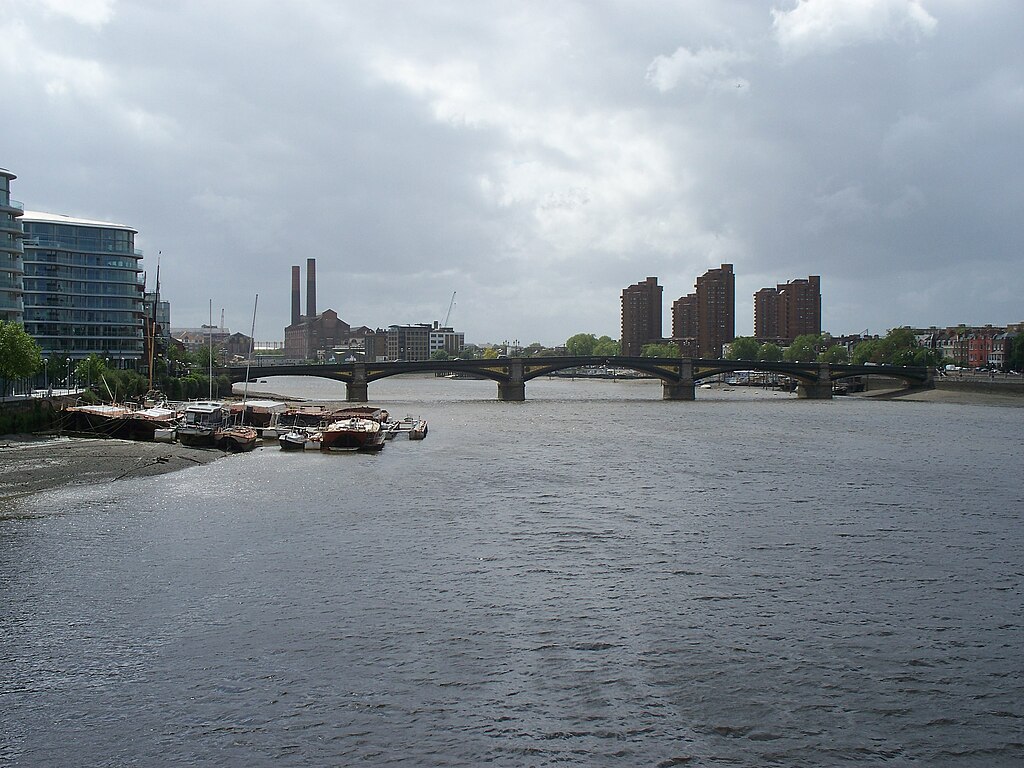 Battersea Bridge in London. Photo Credit: © Iridescent via Wikimedia Commons.
Battersea Bridge in London. Photo Credit: © Iridescent via Wikimedia Commons.



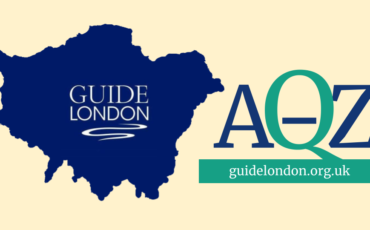



Leave a Reply